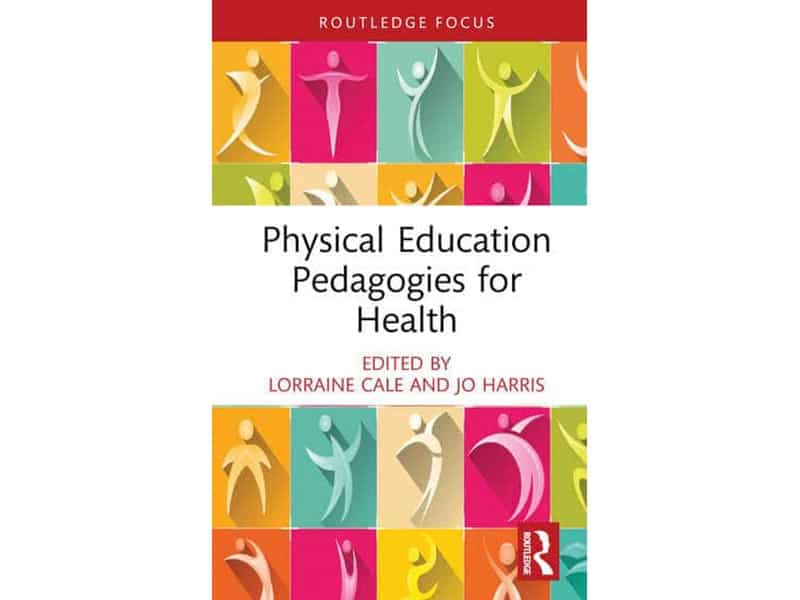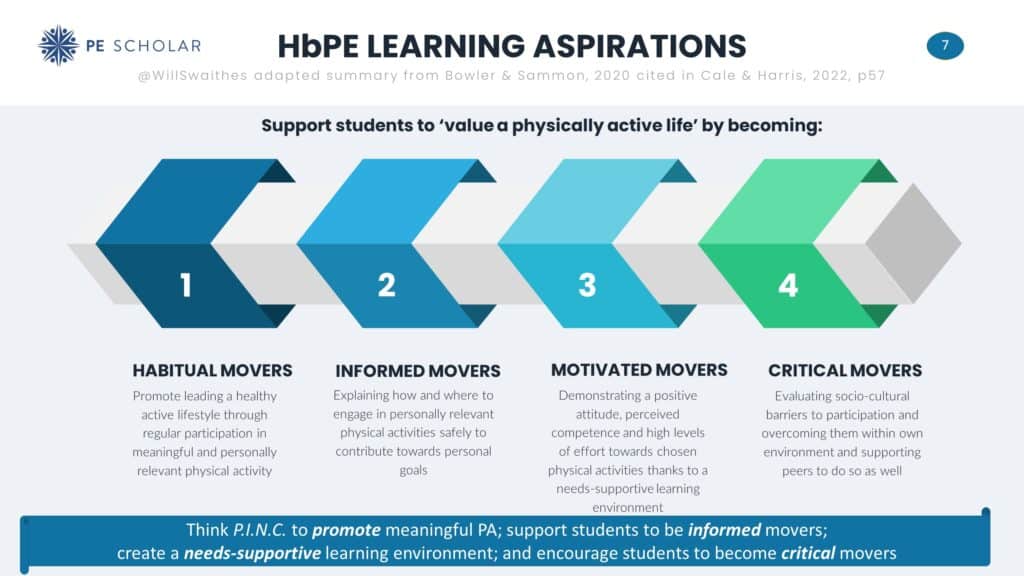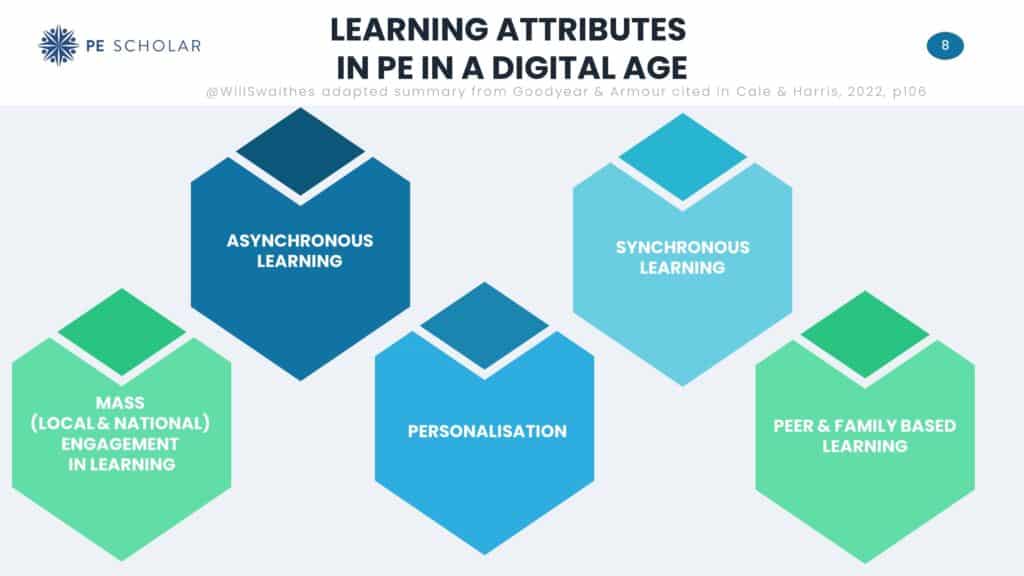
Introduction
This book edited by Lorraine Cale and Jo Harris captures the latest insight, thought and best practice around ensuring health is carefully considered when designing and delivering physical education programmes.
My personal connection to their work comes from being a trainee teacher under their supervision at Loughborough University in 2001, when they had already established a reputation for research and publications in the Health-Related Exercise domain. That work has not faltered and this book also contains contributions from other leaders in this important field.
On reading, you will be exposed to research (old and new), key pedagogical issues and debates in this space – including personal favourites around broader health promotion, the place of fitness tests in PE, the emergence of ‘Health-based PE’ as a pedagogical model and the impact of living in a digital age.
Each chapter contains practical tools to bridge the gap between research and practice as well as reflective questions to help prompt further thought amongst practitioners. The common format includes aims of each chapter, reflective question boxes, a summary and recommendations makes the chapters easy for a busy teacher to navigate.
We will now delve into a little of what you can expect and would definitely encourage you to take a look yourself via this Routledge link.

The Role of Physical Education in Health
Chapter one really sets the scene for the whole book. It explores the growing role (and responsibility) placed on physical educators to deliver against health outcomes and flags some of the considerable challenges as well as the opportunities related to this. Page 2 shares the following headline statistics from the World Health Organisation (WHO) to help frame the importance of these issues:
- Depression as the leading cause of ill health in adolescents
- A fourfold increase in overweight or obese children between 1975 and 2016
- 81% of adolescents globally do not meet guidelines of an average of 60 active minutes a day and this estimate is even more stark for girls and those with lower socio-economic status
“It is advocated that PE’s role and responsibility should be to stimulate interest, enjoyment, knowledge, competence and expertise in physical activity and sport for health and well-being” (Fox, Cooper & McKenna, 2004, cited in Cale & Harris, 2022, p3)
This chapter goes on to explore how and where health features in the national curriculum in England, Australia and New Zealand. The following infographic summarises the challenges highlighted when it comes to meeting health-related expectations:

Whilst these challenges are far from insignificant, a number of opportunities and solutions have already been demonstrated to help. These include:
- Government run health promotion campaigns and programmes such as ‘Better Health’, ‘Change4Life and ‘This Girl Can’ here in the UK
- Sport England funded work to upskill secondary PE teachers on promoting healthy active lifestyles (https://www.sportengland.org/news/major-teacher-training-project-targets-improving-attitude-to-physical-education-in-schools)
- Incorporating activity breaks during the school day with the added benefit of improving concentration and behaviour (Donnelly & Lambourne, 2011, cited in Cale & Harris, 2022, p8)
‘If “exercise is medicine”, physical education is the pill not taken’ (McKenzie & Lounsbery, 2009, p291, cited in Cale & Harris, 2022, p9) is just one example of the great provocative final reflection boxes tasking the reader to reflect and consider the implications on practice. The chapter concludes with a reminder that we must be realistic when considering what can be achieved in terms of health outcomes from PE.
Key Health-Related Approaches, Pedagogical Principles and Learning in PE
Chapter two touches on philosophies that have dominated the PE offer to include the much talked about and traditional sports technique and competitive skill-drill make-up of the majority of lessons (Alfrey, Cale & Webb, 2012; Kirk, 2010 cited in Cale & Harris, 2022, p16).
The chapter goes on to suggest that student-centred curriculum design requires ‘flexible and personalised pedagogies to accommodate the needs and interests of all students’ (Cale & Harris, 2022, p16). Drawing on the work of Len Almond it is suggested we must consider the following six points more carefully:
- ‘Physical activity is for all
- Physical activity is for life
- Everyone can be good at physical activity
- Everyone can benefit from physical activity
- Everyone can find the right kind of physical activity for them
- Excellence in physical activity is maintaining an active way of life’
(Harris & Cale, 2019, cited in Cale & Harris, 2022, p16)
I would encourage you to think carefully about that last point concerning excellence, an exploration of what it is to be physically educated and what you currently assess, monitor, recognise and reward as success in PE.
Chapter two also reminds us that learning about health can and should be best delivered through a practical setting. Practitioners should resist the temptation to resort to classroom teaching of theoretical health knowledge and instead find creative ways to embed it and reflect on it with students within their practical lessons. Cognitive, behavioural and affective components are illustrated in a progressive age-related curriculum overview structured under the following four categories:
- Safety issues
- Exercise effects
- Health benefits
- Activity promotion
Does your current provision cater well for these four areas and in a consistent way across different teachers or do some have a bias towards certain aspects of health? Chapter two goes on to explore two potential approaches to health related learning in PE:
- Integrated – health related learning provided within traditional activity units such as athletics, dance, games, gymnastics, OAA and swimming
- Focused – health education provided as a separate and dedicated unit (typically called health-related exercise or health-related fitness)

Each approach has its positive and negatives, Cale and Harris suggest perhaps the best approach is a hybrid model with a combination? The authors also flag the importance of recognising potential cross-curricular links with other subjects such as PSHE (Personal, Social & Health Education), Science and Food Technology.
The relatively recent Relationship, Sex and Health Education (RSHE) policy document produced by the Department for Education (2021) is also be useful to refer to in this regard. This lays out specific teaching requirements for primary and secondary schools here in England that include physical, mental and social (relationship) health factors that are typically addressed via cross-curricular mapping. The following mind map captures some of the key themes:

Fitness Testing in PE
Laura Alfrey and Dillon Landi do a great job of summarising and extending the debate around the suitability of fitness testing within PE in chapter three.
They highlight that this practice remains commonplace around the world, especially in England, Australia and the USA (p33). This practice continues despite debate centred around the following key questions:

I really like this idea of a shift away from privileging body types, preventing ill-health, promoting attainment of sports skills and treating/labelling bodies as ‘healthy’ or ‘unhealthy’ (Cale & Harris, 2022, p37), in favour of a shift towards valuing, including and holistically developing all bodies as follows:

An Introduction to New PE-for-Health Pedagogies, Approaches and Models
Paul Sammon, Mark Bowler and Ash Casey join forces to share their thoughts on Health-based PE (HbPE) and more in chapters four and five.
A number of whole-school approaches are explored before focusing on the need to move beyond the current sport-focused ‘Multi-Activity Approach’ (MAA) that obsesses with sporting technique the world over. This builds on Haerens et al. (2011) proposal for HbPE as a pedagogical model. The main idea of ‘valuing a physically active life’ is argued for and unpicked with the following four learning aspirations:

This model draws on self-determination theory and the social ecological model to increase the likelihood of intrinsic motivation to move. Recognising that affective and social factors such as enjoyment, friendships and wellbeing are likely to hook more young people into participation than technical excellence suggests that many schools have a way to go when it comes to curriculum re-design.
Some example learning intentions include:
- Identify how to be active in your local community
- Demonstrate engagement with personal physical activity pledges
- Recognise common barriers to participation and how to overcome them
(Sammon & Bowler, 2020, cited in Cale & Harris, 2022, p57)
Sammon and Bowler recommend HbPE units to be taught for a sustained period of 12 or more weeks with consideration of the following five assumptions (p69):
- Teachers prioritise a physical activity for life approach rather than focusing on fitness, sport or performance
- Behaviour change takes time and is influenced by a complex relationship between affective, cognitive, physical and social domains whereby the affective domain should be prioritised
- What is learnt in HbPE must be meaningful, relevant and transferable to young people’s leisure time (hence introduction of units like skateboarding and scooting to PE programmes internationally)
- Approaches must support perceptions of autonomy, competence and relatedness to support intrinsic motivation to move more
- HbPE programmes should connect school, family and community settings via a joined up approach
The chapter wraps up by reminding us that assessment must reflect outcomes of most value rather than factors that are easiest to measure, hence performance in sport or fitness tests are not a good proxy for whether students value a physically active life, whereas self-reflection on progress rather than peer comparison, physical activity diaries and surveys could align much better.
The Role of PE and PE Teachers in a Digital Age
Victoria Goodyear and Kathleen Armour help demystify and summarise some of the potential benefits, challenges and opportunities when it comes to digital technology and social media in chapter seven. The authors share how social media influencers such as Joe Wicks and E-sport Gamers are an important source of formal and informal physical and health education for young people and hence it is important we embrace and connect with these rather than focusing on bolt-on digital gimmicks or apps to support traditional learning in PE.
A strong case is made for ‘shifting the emphasis in initial teacher training and CPD from preparing teachers to teach the curriculum to preparing them to work creatively and collaboratively with young people’ (p104-105). The following five learning attributes for PE are explored briefly as a potential way to structure thinking differently about approaches to PE:

The Future of Physical Education and Health
Chapters 8 provides an opportunity for Jess, McMillan & Carse to briefly reflect on the relationship between PE and health over the last 100 years, suggesting it has been a situation of ‘a square peg in a round hole’ before proposing a potential and positive way forward. Educational reform has privileged cognitive learning and dualism that has led to marginalisation of the physical in that mind-body divide. The authors argue for a shift for a more holistic view where PE develops tighter ties to health and consequently a more centralised position within the curriculum.
We are already seeing this within the Curriculum for Excellence in Scotland. Best practice in PE increasingly leans away from a “one size fits all” approach towards more complex, contextually adapted and co-constructed models of curriculum design (p112). Research into Meaningful PE, Physical Literacy, Non-linear Pedagogy, Models-based Practices like Sport Education and HbPE, Socio-Ecological Models and interdisciplinary work will likely hold the key to the evolution of our subject.
However, this chapter also warns of the fragmented place of PE and lack of unity around the purpose and best approaches for delivery with a neat little comparison to toothbrushes whereby ‘everyone has one and no one wants to use anyone else’s’ (Davis, Sumara & Luce-Kempller, 2015, cited in Cale & Harris, 2022, p114). The following three factors are suggested on page 116 to help move the holistic education agenda forward by physical educators, and close the gap between physical education and health:
- Personal visions – increased voice of PE teachers to actively develop and promote their why for PE to suit their specific school context
- Boundary crossing – connecting with other stakeholders in health, sport, education and technology to develop positive relationships of influence rather than operating in silos
- Professional development in context – a commitment to long-term learning rather than quick fixes and fads from initial teacher education throughout our careers
Physical Education and Health Take-aways
- Take a whole school, even better a whole community, approach to health and wellbeing
- Carefully consider PE’s role and unique contribution towards young people’s physical, emotional and social health promotion and development
- Provide a mix of isolated and integrated health development initiatives as part of your PE programme
- Seek student voice, choice and tailoring of provision to meet the needs and motivations of your least active in an attempt to break the cycle of inequality
- Think very carefully before you utilise any kind of fitness testing in PE to ensure it supports the intrinsic motivation and confidence building of all students via a focus on progress of personal best not peer comparison
- Think P.I.N.C when it comes to HbPE and strive to ensure all students ‘value a physically active life’
- Embrace the potential of digital technologies and social media to provide formal and informal education far beyond gimmicky apps or tablet bolt-ons to traditional lessons
- Capitalise on government initiatives such as This Girl Can and resources like Studio You to offer more and different health promotion opportunities in school
- Commit to on-going professional learning and continual refinement of your purpose for PE via co-construction and consideration of your school context
- Think holistically and beyond the silo of physical education to help the subject and all students to thrive.
Here is a list of other book reviews you might want to check out:
Reviews by topic
Health and wellbeing
Happiness Factories: A success-driven approach to holistic Physical Education (podcast)
Time to RISE Up: Supporting Students’ Mental Health in Schools
Inclusion and social justice
Inclusive PE for SEND Children and podcast
Teaching Disabled Children in Physical Education
Pedagogies of Social Justice in Physical Education and Youth Sport
Pedagogy
Applying Models-based Practice in Physical Education
Perspectives on Game-Based Coaching
The Future of Teaching and the Myths That Hold it Back
Meaningful PE – an approach for teaching and learning
Threshold Concepts in Physical Education
The Spectrum of Teaching Styles in Physical Education and podcast
Reading lists
Also, don’t forget to take a look at these books published by Scholarly – indispensable additions to every PE teacher’s bookshelf.


Responses